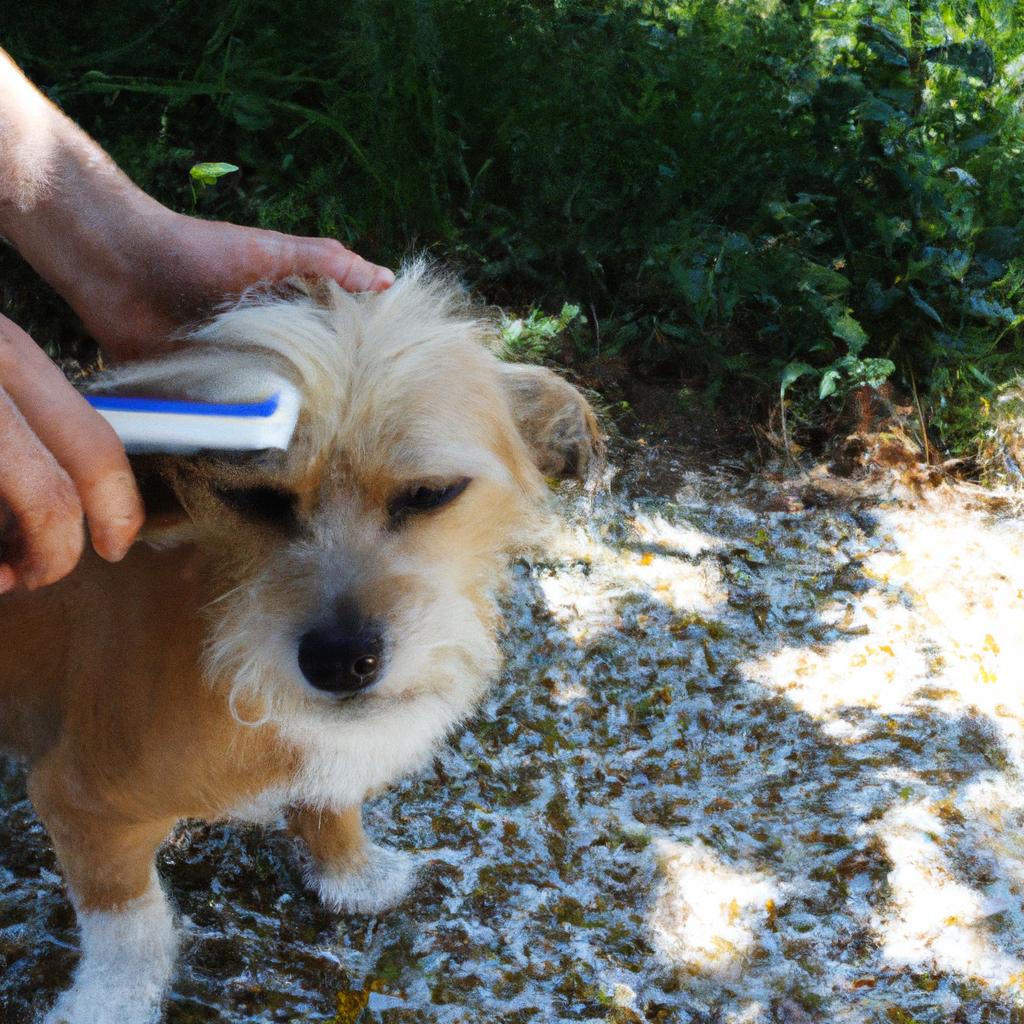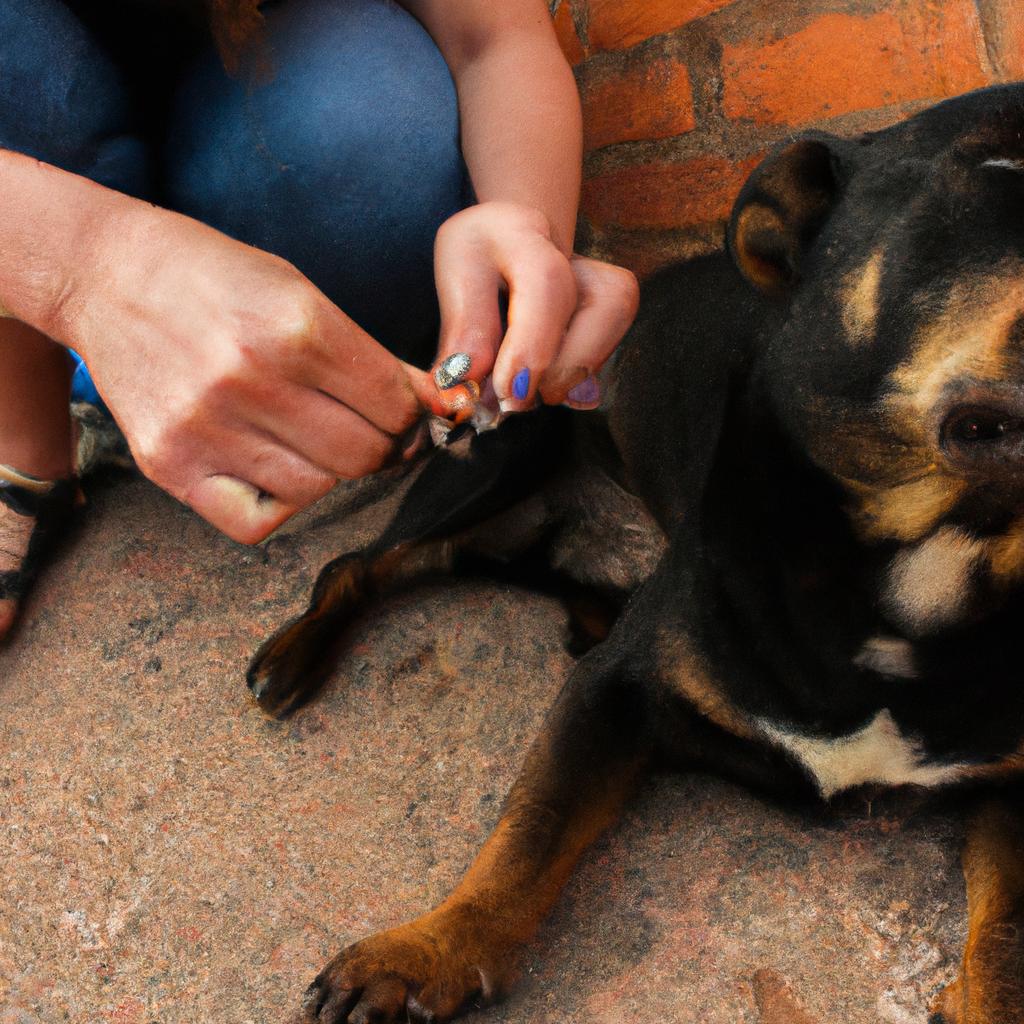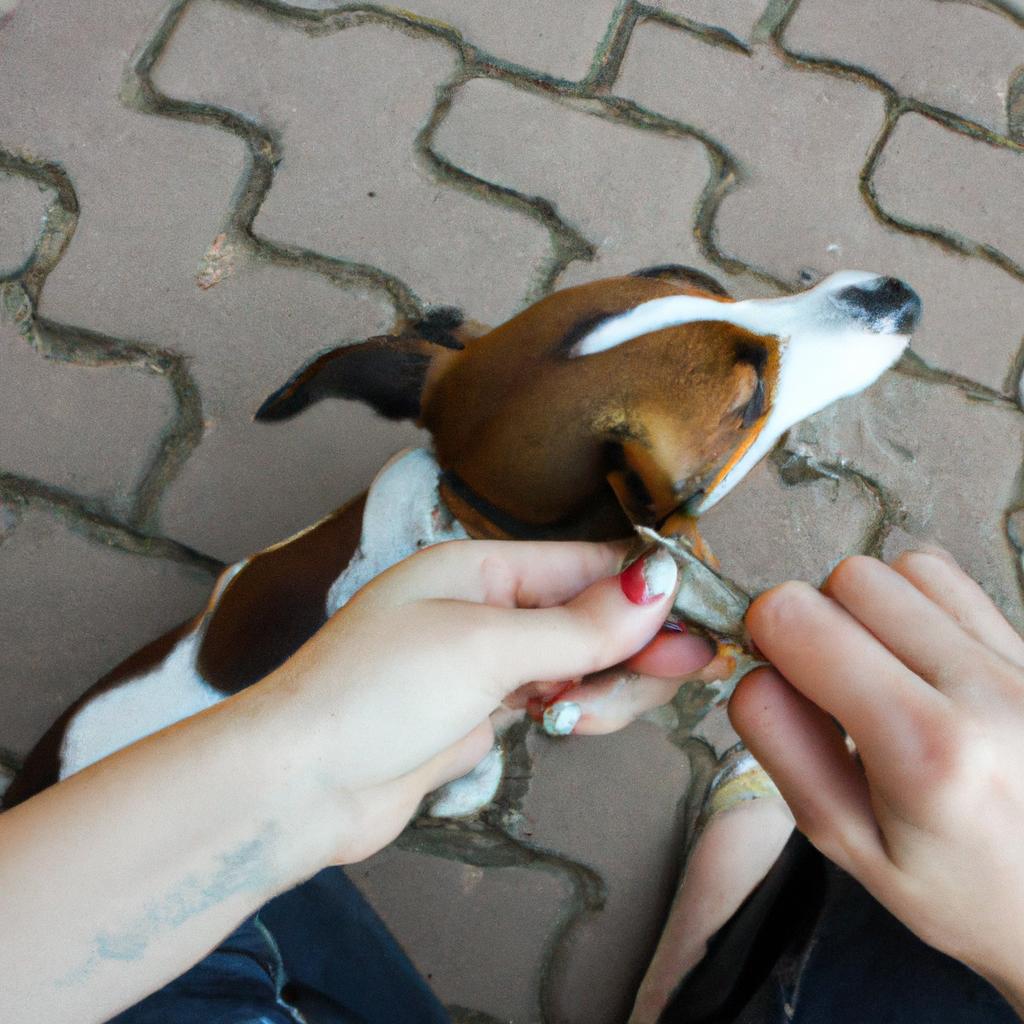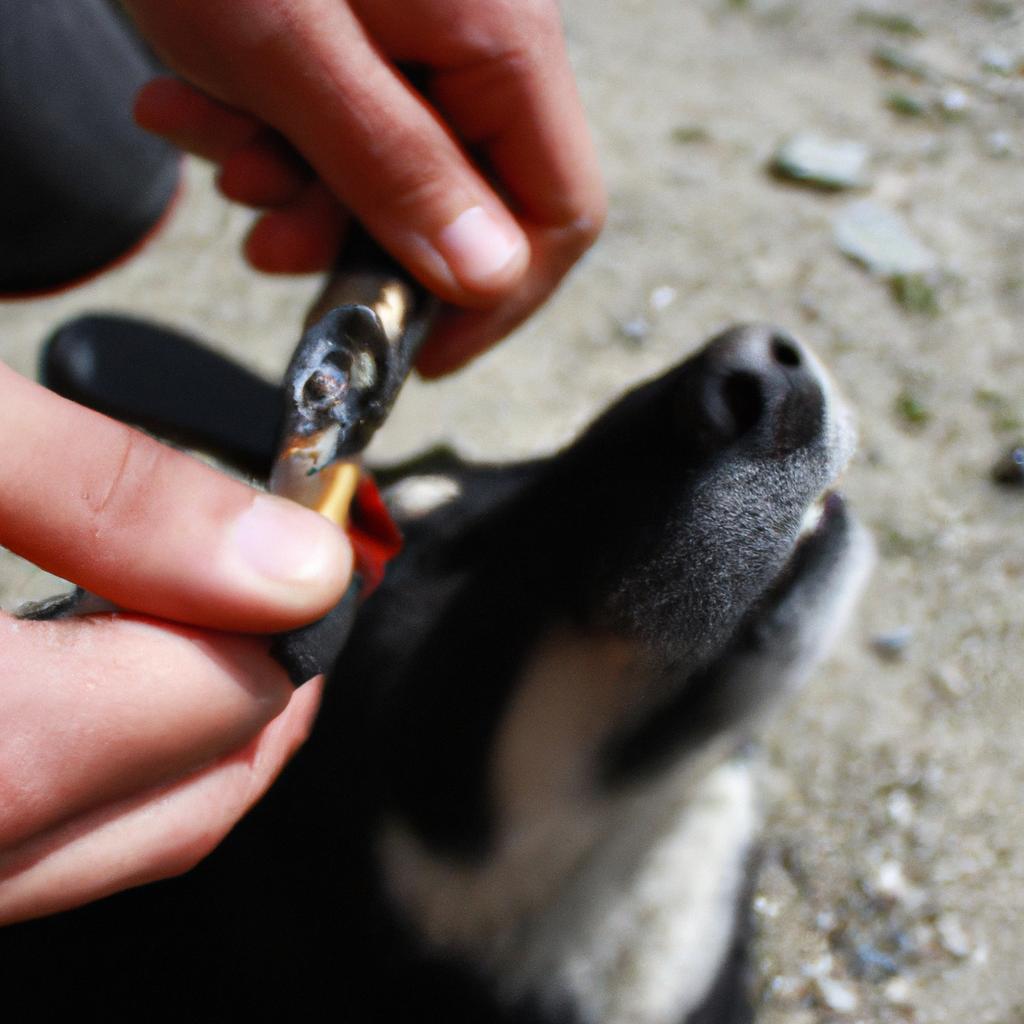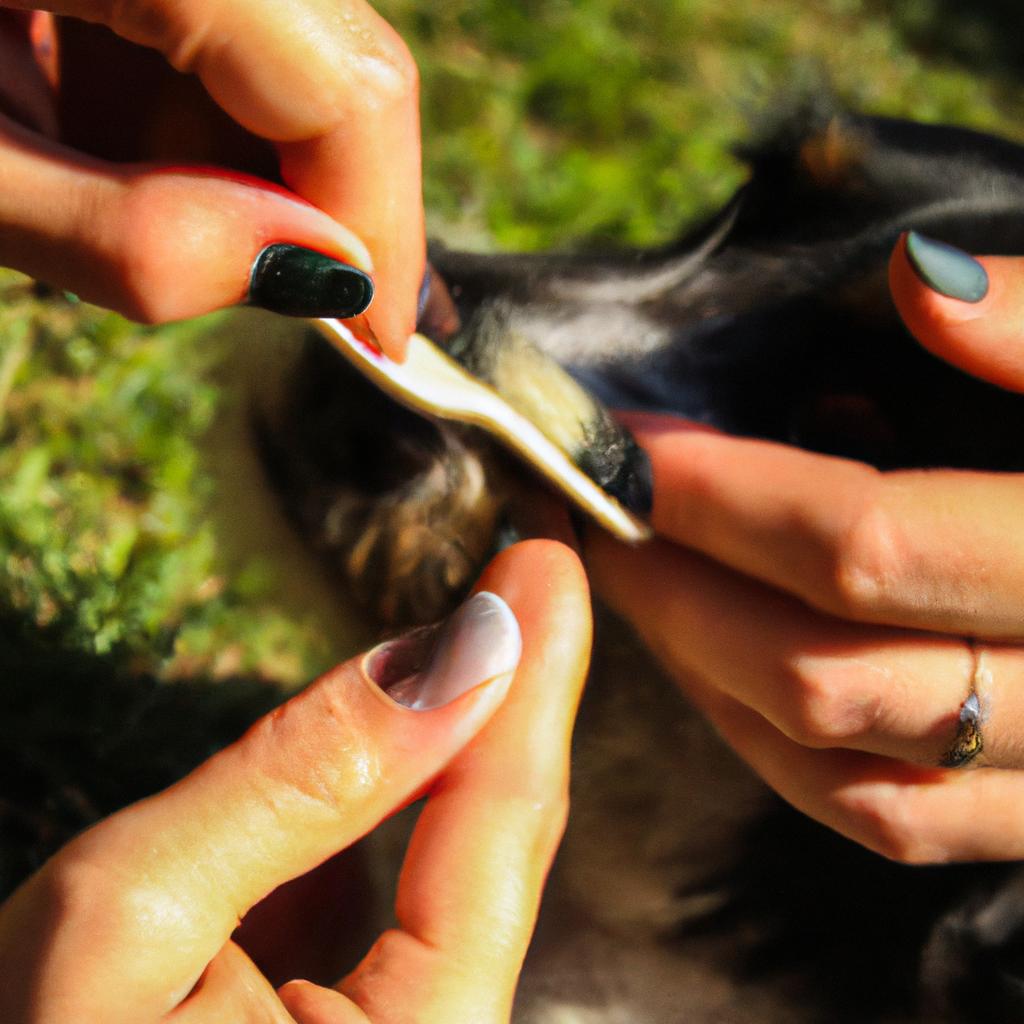Nail Trimming: Essential Tips for Dog Grooming Salons
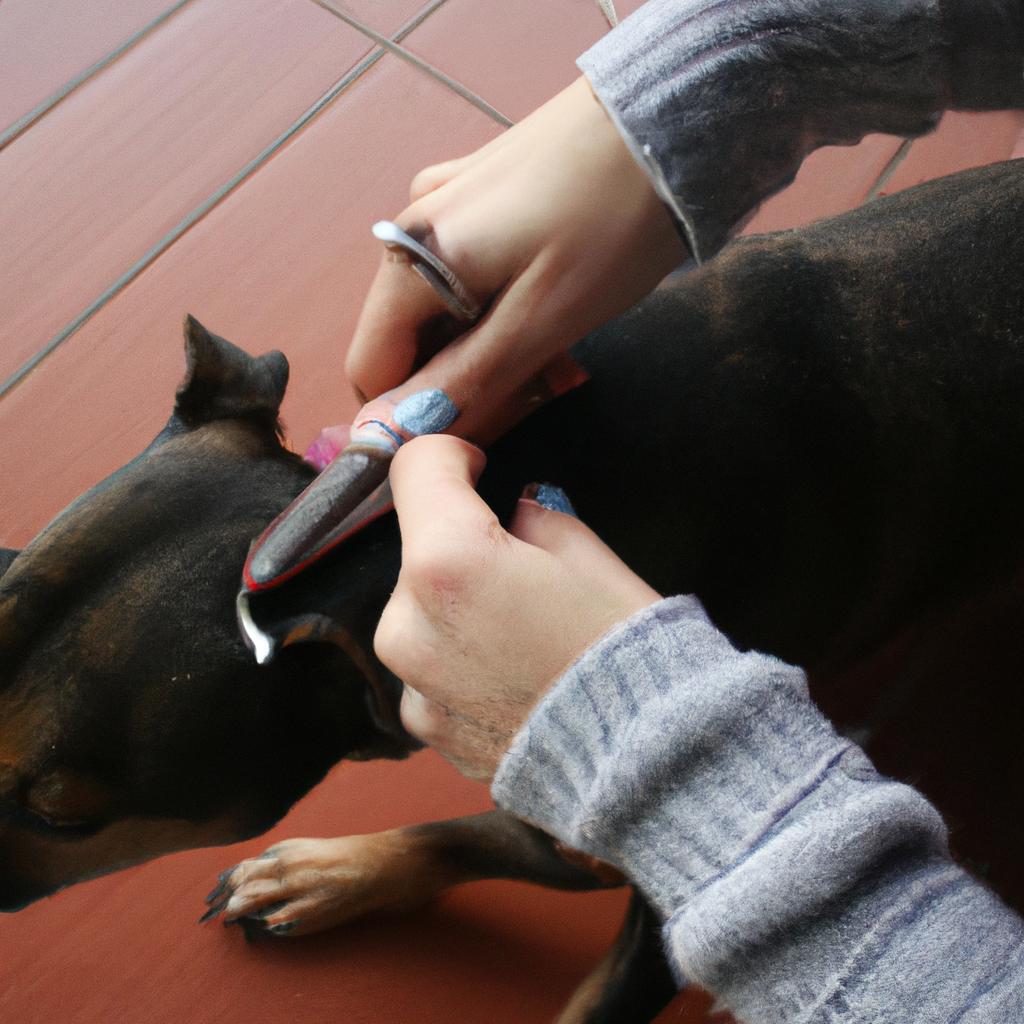
Nail trimming is an essential aspect of dog grooming, and it plays a crucial role in maintaining the overall health and well-being of our canine companions. However, many dogs dislike having their nails trimmed, which can be challenging for both pet owners and groomers alike. In this article, we will explore some vital tips that are indispensable for dog grooming salons to ensure successful nail trims.
Consider the case of Max, a seven-year-old Labrador Retriever who visits his local dog grooming salon regularly. Despite being gentle and friendly in nature, Max becomes anxious during nail trims due to a previous traumatic experience where his quick was accidentally cut by an inexperienced groomer. This incident has left him with a fear of nail trims, making it difficult for the salon staff to provide proper care without causing distress to Max or risking injury. By following the essential tips outlined in this article, groomers can effectively handle situations like these while ensuring that dogs like Max feel comfortable and safe throughout the nail trimming process.
Maintaining proper hygiene and regular nail trims not only contribute to a dog’s physical well-being but also prevent potential injuries caused by overgrown nails. Understanding how best to approach nervous or fearful dogs during nail trims is paramount for dog grooming sal ons. Here are some essential tips to ensure successful nail trims:
-
Create a calm and comfortable environment: Dogs can sense their surroundings, so it’s crucial to create a peaceful atmosphere in the grooming salon. Minimize loud noises, distractions, and unfamiliar scents that may trigger anxiety in dogs.
-
Slowly desensitize dogs to the nail trimming process: For dogs like Max who have had negative experiences, gradual desensitization is key. Start by getting them accustomed to having their paws handled without actually trimming the nails. Gradually introduce the sound of clippers or grinders while offering treats or positive reinforcement.
-
Use positive reinforcement techniques: Rewarding good behavior with treats, praise, or playtime during and after nail trims helps build positive associations for dogs. This can help alleviate anxiety and make future nail trims more manageable.
-
Opt for proper equipment: Invest in high-quality nail clippers or grinders specifically designed for dogs’ nails. Using dull clippers can crush the nail instead of cleanly cutting it, causing discomfort for the dog.
-
Educate staff on canine anatomy: Understanding the structure of a dog’s nails is crucial for avoiding accidents such as cutting into the quick (the sensitive part inside the nail). Train your staff on how to identify and safely trim different types of nails based on breeds and sizes.
-
Consider alternatives to traditional clippers: Some dogs may prefer alternative methods such as grinding or filing their nails rather than traditional clipping. Experiment with different tools to find what works best for each individual dog.
-
Seek professional advice when needed: If dealing with extremely fearful or aggressive dogs during nail trims becomes challenging, consult with a professional dog trainer or behaviorist who specializes in handling these situations safely and effectively.
By implementing these tips and tailoring them to suit each dog’s needs, groomers can ensure that nail trims are carried out efficiently, minimizing stress and discomfort for both the dog and the groomer.
Importance of Regular Maintenance
Regular Maintenance is essential for the overall well-being and health of dogs, particularly when it comes to nail trimming. Neglecting this aspect of grooming can lead to various issues that affect both the dog and its owner. For instance, consider a hypothetical scenario where a pet owner fails to maintain their dog’s nails adequately. As a result, the nails grow excessively long, causing discomfort and pain for the animal while also posing potential risks.
To begin with, neglecting regular nail trims can cause physical discomfort for dogs. Overgrown nails may curl or become ingrown, leading to painful conditions such as infections or even torn nails. These ailments can significantly impact a dog’s mobility and quality of life. Moreover, excessive length in nails alters the natural gait of dogs, affecting their posture and balance. This imbalance could potentially result in musculoskeletal problems over time.
In addition to physical discomfort, untrimmed nails can have negative consequences on an emotional level. Dogs with overly long nails might experience anxiety or stress due to their inability to walk comfortably or engage in normal activities like running or playing. Behavioral changes such as irritability or aggression are not uncommon among these animals struggling with unresolved distress caused by neglected nail care.
The significance of regular maintenance becomes evident when considering these key points:
- Properly trimmed nails prevent discomfort and pain.
- Routine nail trims promote healthy posture and balanced movement.
- Adequate grooming reduces risk factors associated with infections or injuries.
- Maintaining appropriate nail length contributes to improved behavioral well-being.
By adhering to a consistent schedule for nail trimming, dog owners can ensure their pets’ comfort and minimize potential health hazards related to neglected maintenance practices. In the subsequent section about “Proper Handling Techniques,” we will explore effective methods that professionals employ during nail trims to ensure safety and ease for both dogs and groomers alike.
Proper Handling Techniques
Having understood the importance of regular maintenance, let us now delve into the proper handling techniques that dog grooming salons should employ to ensure a safe and comfortable experience for both the dogs and groomers.
One important aspect of proper handling is maintaining control over the dog during nail trimming. For instance, consider a scenario where an anxious dog enters the salon with overgrown nails. To effectively handle such cases, groomers can use desensitization techniques to help calm down the animal before proceeding with the procedure. By gradually introducing them to the tools and touch, it becomes easier to gain their trust and cooperation.
To further enhance safety and minimize discomfort during nail trimming sessions, here are some essential tips:
- Groomers should always maintain a gentle yet firm grip on the dog’s paw to prevent any sudden movements that may cause injury.
- Using positive reinforcement techniques such as treats or praise can help create a positive association between nail trims and rewards.
- Regular breaks during the process allow dogs to relax and reduce stress levels.
- If necessary, using muzzles or Elizabethan collars can provide additional security for both the groomer and dog.
Emotional response bullet point list (Markdown format):
Tips for Effective Nail Trimming
- Ensure a secure hold on the paw
- Implement positive reinforcement techniques
- Take frequent breaks to ease anxiety
- Consider additional measures like muzzles or Elizabethan collars
In addition to these tips, implementing specific handling techniques can significantly improve efficiency in dog grooming salons. The following table showcases three effective methods along with their benefits:
| Technique | Benefits |
|---|---|
| Restraint bag | Minimizes risk of escape |
| Two-person hold | Provides better stability |
| Raised platform | Offers optimal visibility |
Now that we have covered proper handling techniques for nail trimming, let us move on to discussing the safety measures that should be in place for the dog throughout the grooming process.
Safety Measures for the Dog
As we prioritize the well-being of our furry clients, it is crucial to implement proper safety measures during nail trimming sessions. By following these guidelines, dog grooming salons can ensure a safe and comfortable experience for both the dogs and groomers.
Paragraph 1:
For starters, it is essential to create a calm and stress-free environment for the dogs. Many dogs may exhibit signs of anxiety or fear during nail trimming due to past negative experiences or simply because they are unfamiliar with the process. To minimize their distress, consider implementing the following strategies:
- Provide a quiet area away from distractions such as loud noises or other animals.
- Use positive reinforcement techniques like treats or praise to help alleviate any anxiety.
- Gradually acclimate dogs to the handling and equipment used in nail trimming by introducing them slowly over multiple visits.
- Utilize calming aids such as pheromone diffusers or gentle music to create a soothing atmosphere.
Example:
For instance, let’s imagine a scenario where a rescue dog named Max has always shown fear and aggression towards nail clippers after experiencing painful nail trims at his previous home. In this case, taking extra precautions to establish trust and comfort would be imperative.
Paragraph 2:
Another important aspect of ensuring safety during nail trimming is focusing on proper restraint techniques. While each dog may have different temperaments and tolerance levels, there are general principles that should be followed:
- Gently secure the dog using appropriate restraints like harnesses or adjustable tables specifically designed for grooming purposes.
- Avoid excessive force when restraining; instead, use firm but gentle pressure to keep the dog still.
- Be mindful of sensitive areas such as paws and ears while applying restraint so as not to cause discomfort or injury.
- If necessary, consider employing additional assistance from experienced staff members who can provide support without causing further stress.
Table (emotional response: reassurance):
| Safety Measures for Dog Nail Trimming |
|---|
| 1. Secure Restraint: Use proper restraints to ensure the dog’s safety and minimize movement during the nail trimming process. |
| 2. Gentle Handling: Practice gentle handling techniques to avoid causing distress or injury to dogs. |
| 3. Sensitive Areas Awareness: Be mindful of sensitive areas, such as paws and ears, while applying restraint measures. |
| 4. Additional Support: Seek assistance from experienced staff members if needed to provide extra support and comfort to anxious dogs. |
Paragraph 3:
Lastly, maintaining a clean and hygienic environment is vital when it comes to nail trimming procedures. This not only protects the health of the dogs but also helps prevent the spread of infections or diseases among clients. Some key considerations include:
- Regularly sanitizing all tools and equipment used in nail trimming sessions.
- Following proper hygiene practices, such as washing hands before and after each session.
- Using disposable gloves or changing gloves between dogs to avoid cross-contamination.
- Ensuring that surfaces are cleaned and disinfected thoroughly after each appointment.
Transition sentence into subsequent section about “Tools and Equipment for the Task”:
By implementing these safety measures, dog grooming salons can create an environment where both dogs and groomers feel secure throughout the nail trimming process. To further enhance their efficiency, let’s explore some essential tools and equipment required for this task.
Tools and Equipment for the Task
To ensure a safe and comfortable nail trimming experience for dogs, it is crucial to implement proper safety measures in dog grooming salons. One example that highlights the importance of these measures involves a nervous rescue dog named Max. Prior to his arrival at the salon, Max had experienced traumatic incidents associated with nail trimming, resulting in fear and anxiety during grooming sessions. By following key safety practices, such as those outlined below, groomers can create a secure environment that promotes trust and minimizes stress for dogs like Max.
Firstly, maintaining clear communication with the owner or caretaker is essential before initiating any grooming procedures. This ensures that important information about the dog’s behavior, sensitivities, or past experiences related to nail trims can be taken into account. Additionally, establishing trust through gentle handling techniques helps alleviate apprehension in dogs who may have developed negative associations with nail trimming.
Implementing appropriate restraint methods is another vital aspect of ensuring safety during nail trims. Utilizing tools such as non-slip mats on tables or securing restraints around the torso can limit movement and prevent accidents caused by sudden jerks. It is imperative to strike a balance between providing sufficient freedom for comfort while maintaining control over the dog’s movements.
Furthermore, creating a calm and soothing atmosphere within the salon contributes significantly to reducing stress levels in dogs undergoing nail trims. Playing soft background music or using pheromone diffusers designed specifically for calming anxious pets can help set a relaxing tone. Dimming bright lights and minimizing distractions also aid in promoting a sense of tranquility throughout the grooming process.
- Ensuring your dog feels safe and secure
- Minimizing stress and anxiety through gentle handling techniques
- Establishing open communication channels with owners
- Creating a serene environment conducive to relaxation
Additionally, a table can be included to further resonate with the audience:
| Safety Measures for Dogs in Nail Trimming |
|---|
| Utilize gentle handling techniques |
| Establish open communication channels with owners |
| Implement appropriate restraint methods |
| Create a calm and soothing atmosphere |
As groomers prioritize safety measures, they contribute to establishing trust and comfort for dogs during nail trims. By understanding the significance of these practices, professionals can ensure that each grooming session is as stress-free as possible.
Transition sentence into next section:
By incorporating these safety measures, groomers are better equipped to understand the anatomy of the nail and perform efficient and effective trims.
Understanding the Anatomy of the Nail
Tools and Equipment for the Task: Ensuring Proper Nail Trimming
Imagine a scenario where a dog named Max enters a grooming salon for his regular nail trimming session. The groomer, armed with the right tools and equipment, is ready to provide Max with a comfortable and safe experience. In this section, we will explore the essential tools necessary for nail trimming in dog grooming salons.
To begin with, let’s discuss some key items that every professional groomer should have at their disposal:
- Nail clippers: These come in various types such as guillotine-style clippers or scissor-style clippers. It is important to choose clippers that are specifically designed for dogs, ensuring they are of appropriate size and sharpness.
- Nail grinders: Grinders use rotating emery bands to gradually trim down the nails. They can be an excellent option for dogs who are anxious or fearful of traditional clippers.
- Styptic powder or gel: Accidental cuts may occur during nail trims, causing bleeding from the quick (the blood vessel inside the nail). Styptic powder or gel helps stop bleeding quickly by promoting clotting.
- Treats and positive reinforcement: Rewards play a crucial role in making the process more enjoyable for dogs. Treats help create positive associations with nail trimming sessions.
Now let’s take a moment to look at how these tools enhance the overall experience of both the dog and groomer through emotional engagement:
Emotional Response Evoking Bullet Point List
- Minimizes discomfort and pain during grooming procedures
- Reduces stress and anxiety levels in dogs
- Builds trust between the dog and groomer
- Creates a positive atmosphere within the salon environment
In addition to having the correct tools on hand, understanding canine anatomy is vital when it comes to proper nail trimming. Take a look at this table detailing different parts of a dog’s nail:
| Nail Anatomy | Description |
|---|---|
| Claw | Hard outer covering of the digit |
| Quick | Blood vessel and nerve inside the nail |
| Cuticle | Protective skin fold at the base of the nail |
| Pad | Cushioning tissue beneath the toe |
By familiarizing themselves with these aspects, groomers can ensure a precise and safe trimming process.
Transitioning into our next section about “Identifying the Quick,” it is crucial to proceed cautiously when performing nail trims. By recognizing where the quick begins in a dog’s nail, groomers can avoid causing pain or injury during their grooming sessions. Let’s delve further into this topic for a comprehensive understanding.
Identifying the Quick
Understanding the Anatomy of the Nail and Identifying the Quick
In dog grooming salons, it is crucial for groomers to have a thorough understanding of the anatomy of a dog’s nail. This knowledge enables them to perform nail trimming procedures safely and effectively. Let’s explore this topic further by examining one common scenario: a groomer encounters an unusually long nail on a client’s dog.
When faced with such a situation, it is essential for the groomer to be able to identify the different parts of the nail in order to determine how much should be trimmed. The following are key components of a dog’s nail:
- Claw or Plate: This is the hard outer covering that protects the sensitive areas underneath.
- Quick or Blood Vessels: Located within the claw, this area contains nerves and blood vessels. It appears as a pinkish coloration in dogs with lighter nails but may be more challenging to see in darker-nailed breeds.
- Sensory Nerves: These nerve endings provide dogs with information about their surroundings through touch-sensitive receptors located at the base of each claw.
- Cuticle or Germinal Matrix: Found at the base of the nail, this area produces new cells that contribute to nail growth.
To better understand these components and their relationships, consider Table 1 below:
Table 1: Components of a Dog’s Nail
| Component | Description |
|---|---|
| Claw/Plate | Hard outer covering |
| Quick/Blood Vessels | Contains nerves and blood vessels |
| Sensory Nerves | Touch-sensitive receptors located at base |
| Cuticle/Germinal Matrix | Produces new cells for nail growth |
By familiarizing themselves with these anatomical structures, groomers can avoid cutting into sensitive areas such as the quick when performing nail trims. Accidental cuts into the quick can cause pain, bleeding, and potential complications. It is crucial to handle each dog’s nail with care and precision.
Understanding the anatomy of a dog’s nail sets the foundation for safe and effective nail trimming procedures. In our next section, we will delve into the step-by-step process groomers should follow when performing nail trims on dogs. By adhering to these guidelines, groomers can ensure that both their canine clients and owners have a positive experience during grooming sessions
Step-by-Step Nail Trimming Process
When it comes to nail trimming in dog grooming salons, one important aspect that groomers need to be aware of is the quick. The quick refers to the living tissue within a dog’s nail, which contains blood vessels and nerves. It is essential to identify the location of the quick before attempting to trim a dog’s nails, as cutting into it can cause pain and bleeding.
To help illustrate this point, let’s consider the case of Bailey, a Labrador Retriever who regularly visits a local grooming salon for his nail trims. During one particular visit, the groomer failed to properly locate Bailey’s quick and accidentally cut into it while trimming his nails. As a result, Bailey yelped in pain and started bleeding profusely from his paw. This incident not only caused distress for Bailey but also created an anxious atmosphere at the salon.
To avoid such mishaps and ensure safe nail trimming procedures, here are some key tips for identifying the quick:
- Take your time: Rushing through the process increases the chances of missing or misjudging the location of the quick.
- Use proper lighting: Adequate lighting helps enhance visibility and makes it easier to spot where the quick begins.
- Observe coloration: The quick is typically pinkish in color, contrasting with the white or translucent appearance of most dogs’ nails.
- Familiarize yourself with different breeds: Different breeds may have variations in their nail structure and length, so understanding breed-specific characteristics can aid in locating the quick accurately.
By following these guidelines when identifying the quick during nail trims, groomers can significantly reduce potential discomfort or harm to dogs like Bailey. In our next section on “Tips for Reducing Anxiety in Dogs,” we will explore strategies that further contribute to creating a calm environment during grooming sessions. Soothing techniques play a crucial role in ensuring both pets and groomers have positive experiences throughout the nail trimming process.
Tips for Reducing Anxiety in Dogs
Moving on from the step-by-step process of nail trimming, let’s now explore some helpful tips for reducing anxiety in dogs during this grooming procedure.
Section H2: Tips for Reducing Anxiety in Dogs
To better understand how to minimize stress and nervousness experienced by dogs during nail trims, consider the following example. Meet Max, a 4-year-old Golden Retriever who becomes visibly anxious whenever his nails need clipping. He starts panting heavily, pacing around the room, and even attempts to hide under furniture. By implementing strategies aimed at reducing anxiety, Max’s groomer was able to create a more comfortable experience for him.
In order to help alleviate anxiety in dogs during nail trims, here are some recommended practices:
-
Create a calm environment:
- Play soothing background music or use white noise machines.
- Ensure proper lighting that is neither too bright nor too dim.
- Minimize distractions such as loud noises or sudden movements.
-
Use positive reinforcement techniques:
- Offer treats or rewards before, during, and after each nail trim session.
- Provide verbal praise and gentle petting throughout the process.
- Gradually introduce the sound of clippers or grinders to desensitize your dog.
-
Employ relaxation methods:
- Begin with short sessions and gradually increase their duration over time.
- Incorporate massage therapy before starting the nail trimming process.
- Practice deep breathing exercises together with your dog to promote relaxation.
By implementing these strategies tailored towards individual dogs like Max, we can significantly reduce anxiety levels during nail trims. Remember that every dog is unique and may require different approaches depending on their temperament and past experiences. It’s crucial for groomers to be patient, understanding, and adaptable when working with anxious dogs.
Now let’s delve into common mistakes that should be avoided during the nail trimming process without stating “step.”
Common Mistakes to Avoid
Reducing anxiety in dogs during nail trimming sessions is crucial for maintaining a positive grooming experience. By implementing certain techniques and following specific guidelines, dog groomers can help alleviate stress and create a calm environment for both the dog and themselves.
To illustrate the importance of reducing anxiety, consider a hypothetical scenario where a small terrier named Max enters a grooming salon. Max has had negative experiences with nail trims in the past, causing him to become fearful and anxious whenever his nails need attention. As soon as he walks through the door, he starts trembling, panting heavily, and attempting to hide under furniture.
In order to address this anxiety effectively, groomers should keep the following tips in mind:
- Gradual desensitization: Introduce dogs like Max to the grooming environment slowly and patiently. Allow them time to sniff around and get familiar with their surroundings before starting any procedures.
- Positive reinforcement: Use treats or verbal praise throughout the process to reward good behavior. This will not only distract dogs from their fears but also associate nail trimming with positive experiences.
- Gentle handling: Approach each dog calmly and confidently while maintaining a gentle touch. Avoid sudden movements or rough handling that may further escalate their anxiety.
- Distraction techniques: Engage dogs with toys or interactive games during nail trimming to redirect their focus away from the procedure itself.
By incorporating these strategies into their routine, groomers can minimize anxiety levels in dogs like Max, making every visit more comfortable for both canine clients and human caregivers alike.
| Tips for Reducing Anxiety |
|---|
| Gradual desensitization |
| Positive reinforcement |
| Gentle handling |
| Distraction techniques |
Moving forward, let’s explore common mistakes that groomers should avoid when it comes to providing quality care for our furry friends’ pawdicures.
Note: The table above was created using markdown format.
Maintaining Good Oral Hygiene
Avoiding common mistakes in nail trimming is crucial for maintaining the overall well-being of dogs. Now, let us explore another essential aspect of dog grooming: maintaining good oral hygiene.
Imagine a scenario where a dog named Max visits a grooming salon to have his nails trimmed. The groomer notices that Max’s breath smells foul and upon closer examination, discovers significant tartar buildup on his teeth. This situation highlights the importance of regular dental care as part of a comprehensive grooming routine. Just like humans, dogs require proper oral hygiene to prevent dental diseases such as periodontal disease and tooth decay.
To ensure optimal oral health for dogs, here are some key guidelines to follow:
-
- Use a specially formulated dog toothpaste and brush designed for pets.
- Aim to brush your dog’s teeth at least two to three times per week.
- Gradually introduce the brushing process to make it more comfortable for your dog.
- Focus on the outer surfaces of the teeth, paying extra attention to areas with tartar buildup or plaque accumulation.
-
Dental Chews and Toys:
Provide appropriate dental chews and toys that promote chewing action, which helps reduce plaque formation. -
Professional Dental Cleanings:
Schedule regular professional dental cleanings performed by veterinarians or qualified pet dentists when necessary. -
Balanced Diet:
Feed your dog a balanced diet that supports good oral health, including food specifically formulated to support dental hygiene.
Table: Common Signs of Poor Oral Health in Dogs
| Bad breath | Bleeding gums |
| Tartar | Tooth loss |
These signs indicate potential issues with your dog’s oral health and should be addressed promptly by consulting a veterinarian or certified pet dentist.
By taking proactive measures to maintain good oral hygiene in dogs, you can help prevent dental diseases and ensure your furry friend’s overall well-being. Incorporating regular brushing, providing appropriate dental chews, scheduling professional cleanings as needed, and feeding a balanced diet are all essential steps in promoting healthy teeth and gums.
Now that we have covered the importance of nail trimming and maintaining good oral hygiene for dogs, let us delve into additional grooming tips that will contribute to their overall health and happiness.
Additional Grooming Tips for Dogs
Building upon the importance of maintaining good oral hygiene in dogs, it is equally essential to address other aspects of grooming that contribute to their overall well-being. In this section, we will explore additional tips and techniques relevant to dog grooming salons.
Section:
Ensuring a comfortable experience during nail trimming sessions is crucial for both dogs and groomers alike. Let’s consider an example scenario where a nervous dog named Max visits a grooming salon for his routine nail trim:
Max, a 3-year-old Labrador Retriever, enters the salon exhibiting signs of anxiety, such as trembling and attempting to pull away. To help alleviate his stress levels throughout the process, several key considerations should be taken into account:
- Create a calm environment: Maintain a quiet and soothing atmosphere within the salon by minimizing background noise and distractions.
- Positive reinforcement techniques: Utilize treats or verbal praise to reward cooperative behavior during each step of the nail trimming procedure.
- Gradual introduction: Start by acquainting Max with the tools used for nail trimming before gradually moving towards actual contact with his paws.
- Patience and gentle handling: Take your time with Max, allowing him breaks when needed while ensuring every interaction remains gentle and non-threatening.
To further aid understanding, below is a table outlining common challenges encountered during nail trimming sessions at grooming salons along with corresponding strategies to overcome them:
| Challenge | Strategy |
|---|---|
| Excessive paw sensitivity | Use positive reinforcement training methods to desensitize dogs’ paws over multiple sessions. |
| Nervousness/aggression | Implement muzzle training techniques alongside patience and slow introductions. |
| Fear of nail clippers | Gradually introduce and familiarize dogs with the sound and sight of clippers. |
| Difficulty restraining | Utilize grooming tools like non-slip mats or adjustable harnesses for better control. |
By incorporating these strategies, groomers can help ensure a more comfortable experience during nail trimming sessions, promoting trust between pets and professionals alike.
In summary, maintaining good oral hygiene is just one aspect of comprehensive dog grooming. By creating a calm environment, utilizing positive reinforcement techniques, gradually introducing dogs to the process, and approaching each interaction with patience and gentle handling, groomers can provide a more pleasant experience for both dogs and themselves. By considering common challenges faced during nail trimming sessions at grooming salons and employing corresponding strategies, groomers can overcome obstacles that may arise along the way.

